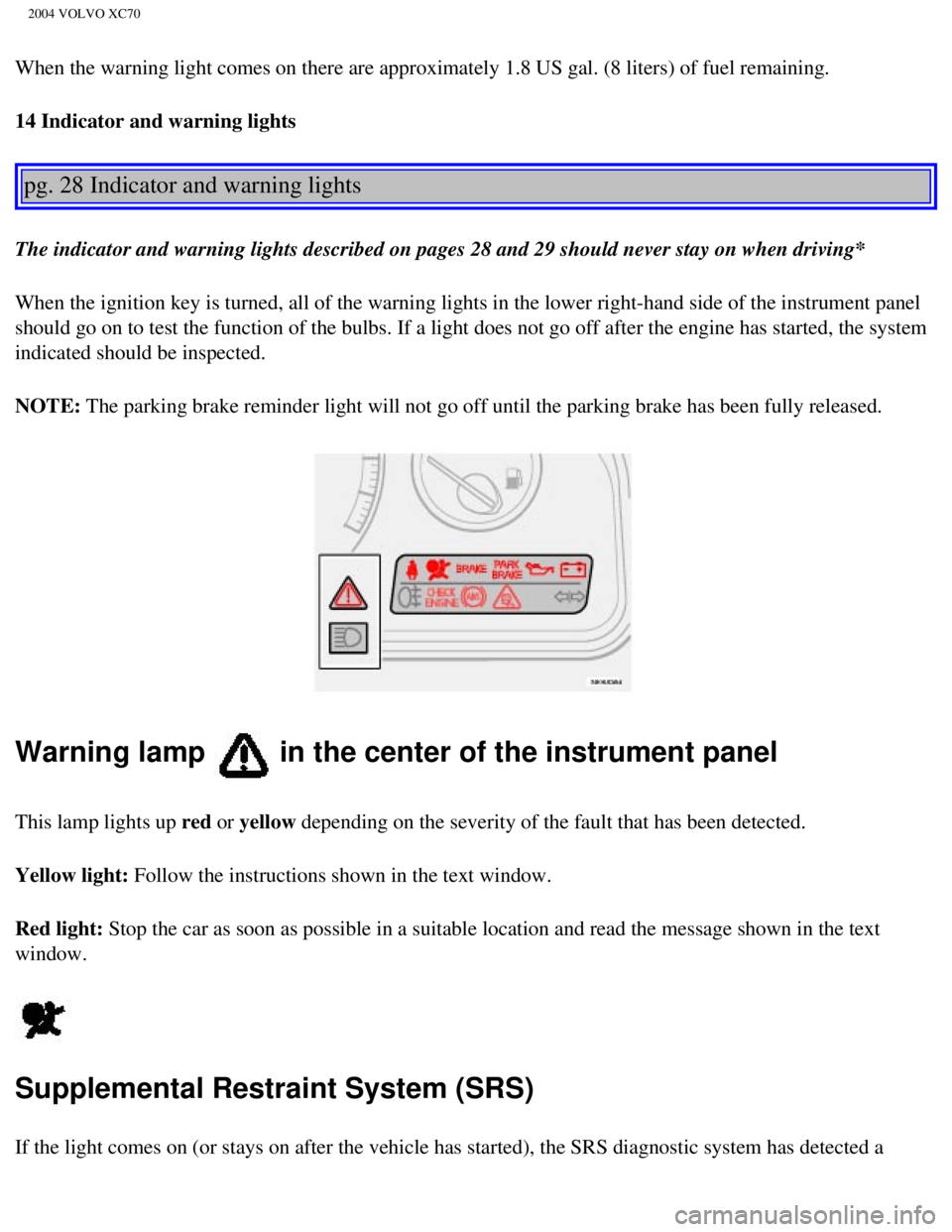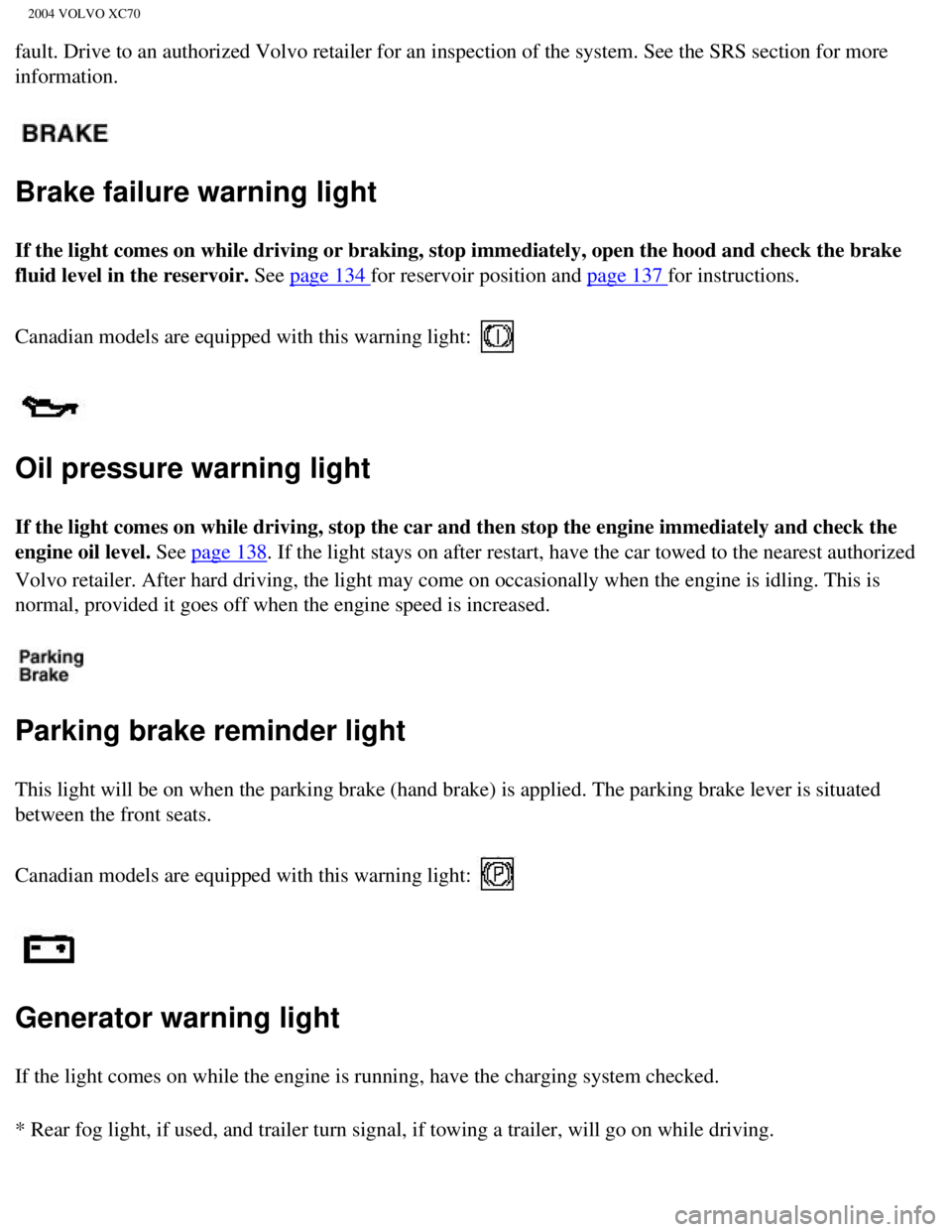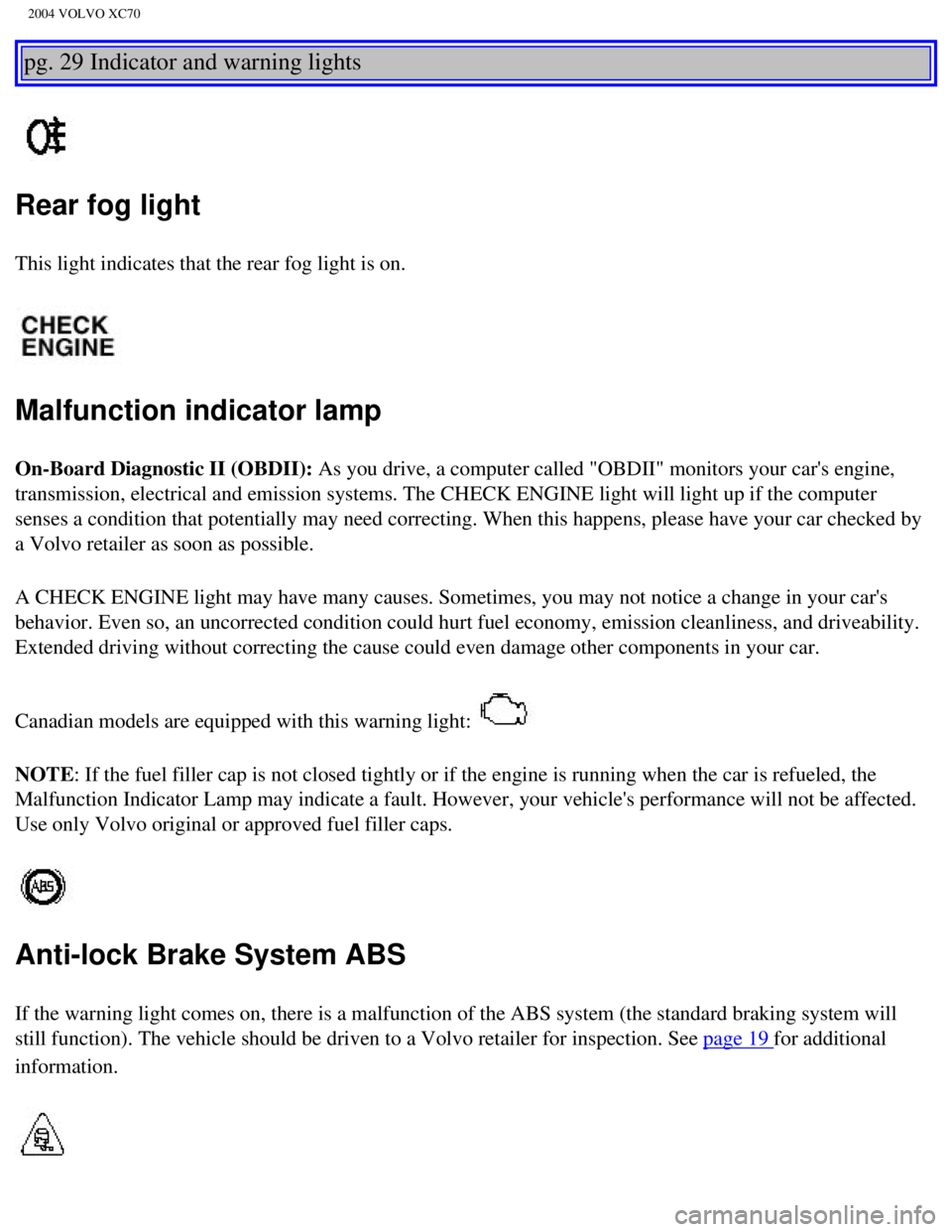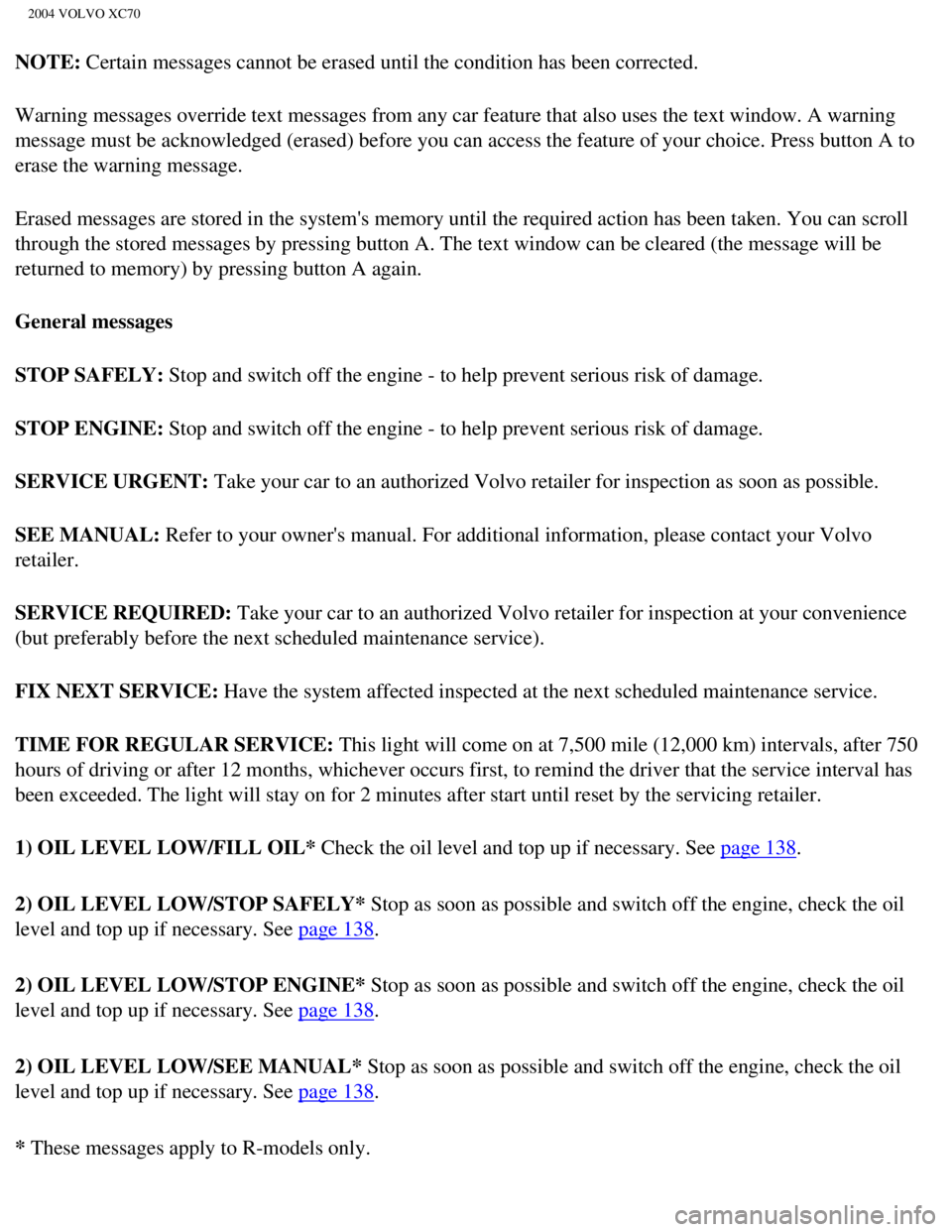engine VOLVO XC70 2004 User Guide
[x] Cancel search | Manufacturer: VOLVO, Model Year: 2004, Model line: XC70, Model: VOLVO XC70 2004Pages: 241, PDF Size: 5.78 MB
Page 36 of 241

2004 VOLVO XC70
The stability systems consist of a number of functions:
The following two functions are common to both STC/DSTC
1. Traction control (TC)
This function is designed to help reduce wheel spin by transferring powe\
r from a drive wheel that begins
to lose traction to the wheel on the opposite side of the car (on the s\
ame axle). TC monitors and
compares the rotational speed of the drive wheels. If one of the drive w\
heels shows a tendency to spin,
the difference in speed is immediately detected. This triggers the Anti-\
lock Brake System, which brakes
the spinning wheel until the difference in rotational speed is corrected\
.
TC is most active at low speeds, and a pulsating sound will be audible w\
hen the system is regulating
wheel spin. This is quite normal.
This is one of the STC/DSTC's permanent functions and is not affected wh\
en the button on the center
control panel is pressed.
2. Spin control (SC)
The spin control function is designed to help prevent the drive wheels f\
rom spinning while the car is
accelerating. This is done by temporarily reducing engine torque to the \
drive wheels, which helps
improve stability and tractive force.
Under certain circumstances, such as when driving with snow chains, or d\
riving in deep snow or loose
sand, it may be advisable to temporarily switch off this function for ma\
ximum tractive force. This is
done by pressing the STC/DSTC button on the center control panel for at \
least a half a second.
When the SC function has been switched off:
l The text window (see page 27) will briefly display "SPIN CONTROL OFF"
l The LED in the STC/DSTC button will be off.
The following two functions are only available with DSTC:
3. Active Yaw Control (AYC)
This function helps maintain directional stability, for example when cor\
nering, by braking one or more
of the wheels if the car shows a tendency to skid or slide laterally. Th\
is is done by activating the Anti-
lock Braking System. A pulsating sound will be audible when the function\
is active, which is quite
normal. If you apply the brakes while this function is active, the brake\
pedal will feel stiffer than usual.
This is also one of the DSTC system's permanent functions and is not aff\
ected when the DSTC button on
the center control panel is pressed.
R-models only:
The AYC function can be deactivated. This is done by pressing the DSTC b\
utton on the center control
panel (see the illustration on
page 31) for approximately one second. This procedure must be repeated 5
times, after which "DSTC REDUCED FUNCTION" will be displayed in the text\
window. AYC will be
file:///K|/ownersdocs/2004/2004_XC70/04xc70_01b.htm (13 of 15)12/30/20\
06 4:32:55 PM
Page 37 of 241

2004 VOLVO XC70
automatically reactivated the next time the ignition is switched on. WARNING!
With AYC disabled, the car's handling and stability characteristics will\
be altered.
4. Emergency Brake Assistance (EBA)
The EBA function is an integrated part of the DSTC system. EBA is design\
ed to provide full brake
effect immediately in the event of sudden, hard braking. The system is a\
ctivated by the speed with which
you depress the brake pedal.
When the EBA system is activated, the brake pedal will go down and press\
ure in the brake system
immediately increases to the maximum level.
pg. 21 STC/DSTC
Maintain full pressure on the brake pedal in order to utilize the system\
completely. EBA is automatically
deactivated when the brake pedal is released. When the car has been park\
ed for some time, the brake
pedal may sink more than usual when the engine is started. This is norma\
l and the pedal will return to its
usual position when it is released.
The STC/DSTC button
The STC/DSTC button in the center control panel (see page 31) is used to switch the Spin Control (SC)
function on or off
NOTE: AYC (on models equipped with this function) will also be reduced, but\
not switched off, if SC
is switched off.
The button must be pressed for at least a half second to prevent SC from\
being switched off
inadvertently.
When the function has been switched off, the green indicator lamp in the\
button will go out and "STC/
DSTC SPIN CONTROL OFF" will be displayed in the text window.
All STC/DSTC functions are (re)activated each time the engine is start\
ed.
The Stability Control indicator light
file:///K|/ownersdocs/2004/2004_XC70/04xc70_01b.htm (14 of 15)12/30/20\
06 4:32:55 PM
Page 43 of 241

2004 VOLVO XC70
information.
If the engine temperature remains high, check coolant level - see
page 133.
4 Trip odometer/reset button
The trip odometer is used for measuring shorter distances. The last digi\
t indicates 1/10 mile/kilometer. Press
the button quickly to toggle between trip odometers 1 and 2. Hold in the\
button for more than 2 seconds to
reset.
5 Odometer
6 Speedometer
7 General warning light (see
page 28).
8 High beam indicator light
9 Tachometer
Indicates engine speed in thousands of rpm. Do not drive for long with t\
he needle in the red section. The
engine has an built-in function preventing too high an engine speed. Whe\
n this function operates, you may
discern some pulsation, which is normal.
10 Gear and driving mode indicator
The currently selected driving mode is displayed here. If you use the Ge\
artronic function on the automatic
transmission, the currently selected gear will be displayed.
11 Ambient temperature indicator
This display indicates the air temperature outside your car. A "snowflak\
e" symbol in the text window is
displayed when the temperature is in the range of 23 - 36° F (-5 - +\
2° C).
Please note that this symbol does not indicate a fault with your car.
At low speeds or when the car is not moving, the temperature readings ma\
y be slightly higher than the actual
ambient temperature.
12 Clock/reset button
Turn the button to adjust the clock.
13 Fuel gauge
The fuel tank holds approximately:
Front wheel drive models:18.5 US gal. (70 liters)
All Wheel Drive models: 19 US gal. (72 liters)
V70R: 18 US gal. (68 liters)
file:///K|/ownersdocs/2004/2004_XC70/04xc70_02a.htm (5 of 14)12/30/200\
6 4:32:56 PM
Page 44 of 241

2004 VOLVO XC70
When the warning light comes on there are approximately 1.8 US gal. (8 \
liters) of fuel remaining.
14 Indicator and warning lights
pg. 28 Indicator and warning lights
The indicator and warning lights described on pages 28 and 29 should nev\
er stay on when driving*
When the ignition key is turned, all of the warning lights in the lower \
right-hand side of the instrument panel
should go on to test the function of the bulbs. If a light does not go o\
ff after the engine has started, the system
indicated should be inspected.
NOTE: The parking brake reminder light will not go off until the parking brake\
has been fully released.
Warning lamp in the center of the instrument panel
This lamp lights up red or yellow depending on the severity of the fault that has been detected.
Yellow light: Follow the instructions shown in the text window.
Red light: Stop the car as soon as possible in a suitable location and read the me\
ssage shown in the text
window.
Supplemental Restraint System (SRS)
If the light comes on (or stays on after the vehicle has started), the\
SRS diagnostic system has detected a
file:///K|/ownersdocs/2004/2004_XC70/04xc70_02a.htm (6 of 14)12/30/200\
6 4:32:56 PM
Page 45 of 241

2004 VOLVO XC70
fault. Drive to an authorized Volvo retailer for an inspection of the sy\
stem. See the SRS section for more
information.
Brake failure warning light
If the light comes on while driving or braking, stop immediately, open t\
he hood and check the brake
fluid level in the reservoir. See
page 134 for reservoir position and page 137 for instructions.
Canadian models are equipped with this warning light:
Oil pressure warning light
If the light comes on while driving, stop the car and then stop the engi\
ne immediately and check the
engine oil level. See
page 138. If the light stays on after restart, have the car towed to the nearest\
authorized
Volvo retailer. After hard driving, the light may come on occasionally w\
hen the engine is idling. This is
normal, provided it goes off when the engine speed is increased.
Parking brake reminder light
This light will be on when the parking brake (hand brake) is applied. \
The parking brake lever is situated
between the front seats.
Canadian models are equipped with this warning light:
Generator warning light
If the light comes on while the engine is running, have the charging sys\
tem checked.
* Rear fog light, if used, and trailer turn signal, if towing a trailer,\
will go on while driving.
file:///K|/ownersdocs/2004/2004_XC70/04xc70_02a.htm (7 of 14)12/30/200\
6 4:32:56 PM
Page 46 of 241

2004 VOLVO XC70
pg. 29 Indicator and warning lights
Rear fog light
This light indicates that the rear fog light is on.
Malfunction indicator lamp
On-Board Diagnostic II (OBDII): As you drive, a computer called "OBDII" monitors your car's engine,
transmission, electrical and emission systems. The CHECK ENGINE light wi\
ll light up if the computer
senses a condition that potentially may need correcting. When this happe\
ns, please have your car checked by
a Volvo retailer as soon as possible.
A CHECK ENGINE light may have many causes. Sometimes, you may not notice\
a change in your car's
behavior. Even so, an uncorrected condition could hurt fuel economy, emi\
ssion cleanliness, and driveability.
Extended driving without correcting the cause could even damage other co\
mponents in your car.
Canadian models are equipped with this warning light:
NOTE: If the fuel filler cap is not closed tightly or if the engine is runni\
ng when the car is refueled, the
Malfunction Indicator Lamp may indicate a fault. However, your vehicle's\
performance will not be affected.
Use only Volvo original or approved fuel filler caps.
Anti-lock Brake System ABS
If the warning light comes on, there is a malfunction of the ABS system \
(the standard braking system will
still function). The vehicle should be driven to a Volvo retailer for i\
nspection. See
page 19 for additional
information.
file:///K|/ownersdocs/2004/2004_XC70/04xc70_02a.htm (8 of 14)12/30/200\
6 4:32:56 PM
Page 48 of 241

2004 VOLVO XC70
NOTE: Certain messages cannot be erased until the condition has been corrected\
.
Warning messages override text messages from any car feature that also u\
ses the text window. A warning
message must be acknowledged (erased) before you can access the featur\
e of your choice. Press button A to
erase the warning message.
Erased messages are stored in the system's memory until the required act\
ion has been taken. You can scroll
through the stored messages by pressing button A. The text window can be\
cleared (the message will be
returned to memory) by pressing button A again.
General messages
STOP SAFELY: Stop and switch off the engine - to help prevent serious risk of damage\
.
STOP ENGINE: Stop and switch off the engine - to help prevent serious risk of damage\
.
SERVICE URGENT: Take your car to an authorized Volvo retailer for inspection as soon as \
possible.
SEE MANUAL: Refer to your owner's manual. For additional information, please contact\
your Volvo
retailer.
SERVICE REQUIRED: Take your car to an authorized Volvo retailer for inspection at your con\
venience
(but preferably before the next scheduled maintenance service).
FIX NEXT SERVICE: Have the system affected inspected at the next scheduled maintenance ser\
vice.
TIME FOR REGULAR SERVICE: This light will come on at 7,500 mile (12,000 km) intervals, after 750\
hours of driving or after 12 months, whichever occurs first, to remind t\
he driver that the service interval has
been exceeded. The light will stay on for 2 minutes after start until re\
set by the servicing retailer.
1) OIL LEVEL LOW/FILL OIL* Check the oil level and top up if necessary. See
page 138.
2) OIL LEVEL LOW/STOP SAFELY* Stop as soon as possible and switch off the engine, check the oil
level and top up if necessary. See
page 138.
2) OIL LEVEL LOW/STOP ENGINE* Stop as soon as possible and switch off the engine, check the oil
level and top up if necessary. See
page 138.
2) OIL LEVEL LOW/SEE MANUAL* Stop as soon as possible and switch off the engine, check the oil
level and top up if necessary. See
page 138.
* These messages apply to R-models only.
file:///K|/ownersdocs/2004/2004_XC70/04xc70_02a.htm (10 of 14)12/30/20\
06 4:32:56 PM
Page 51 of 241

2004 VOLVO XC70
l Current speed in mph (Canadian models only)
NOTE: Warning messages from the car's monitoring systems will override the tri\
p computer function. If a
warning message is displayed in the text window while you are using the \
trip computer, you must
acknowledge the message by pressing button A. Press button A again to re\
turn to the trip computer function.
Trip computer controls and functions
The four* trip computer functions can be accessed by twisting control B \
one step at a time in either direction.
Twisting a fifth time** returns you to the original function.
The trip computer can be reset (current data will be erased from system\
memory) by pressing RESET (button
C).
1. Driving distance on current fuel reserve
This function shows the approximate distance that can be driven on the f\
uel remaining in the tank. This
calculation is based on average fuel consumption during the last 12 mile\
s (20 km) of driving and the amount
of fuel remaining in the tank when the reading was taken. When the drivi\
ng distance on current fuel reserve is
less than 12 miles (20 km), "----" will be displayed in the text windo\
w.
2. Average fuel consumption
This value indicates fuel consumption since the last time the trip compu\
ter was reset (by pressing RESET,
button C). When the engine is switched off, information on fuel consump\
tion is stored and remains in system
memory until the RESET (button C) is pressed again.
3. Current fuel consumption
This value indicates the current fuel consumption, based on readings tak\
en once per second. When the car is
not moving, "----" will be displayed.
4. Average speed
This value indicates average speed since the last time the trip computer\
was reset (by pressing RESET, button
C). When the engine is switched off, information on average speed is st\
ored and remains in system memory
until the RESET (button C) is pressed again.
5. Current speed in miles per hour (Canadian models only)
This function provides the driver with an instantaneous conversion of th\
e car's current speed from km/h to
mph.
NOTE: Trip computer readings may vary slightly depending on the circumference \
of the tires on the car.
*Five functions on Canadian models
**A sixth time on Canadian models
file:///K|/ownersdocs/2004/2004_XC70/04xc70_02a.htm (13 of 14)12/30/20\
06 4:32:56 PM
Page 54 of 241

2004 VOLVO XC70
Disengaging cruise control
Cruise control can be disengaged by:
l Pressing the CRUISE button.
l Putting the gear selector in (N)eutral.
NOTE: Cruise control is automatically disengaged if the engine is switched off\
, if the gear selector is
placed in (N)eutral, if the car's speed drops to under 70% of the curr\
ently set speed or if the wheels start
to spin.
Temporarily disengaging cruise control
l Press 0 to temporarily disengage cruise control. Press "resume" () to return to the previously set
speed.
l Press the brake pedal. Press "resume" () to return to the previously set speed.
WARNING!
Cruise control should not be used in heavy traffic or when driving on we\
t or slippery roads. Cruise
control may not maintain set speed on steep downgrades.
pg. 34 Light switch panel
A - Headlights, parking lights
O All lights off
Models with daytime running lights: Low beam headlights will automatically come on if the ignition
key is in position II. Front and rear parking lights and license plate l\
ights will also be on.
Volvo recommends the use of daytime running lights. If, however, you wou\
ld prefer to have these lights
turned off (USA only), please consult your Volvo retailer. Please note\
that the use of daytime running
lights is mandatory in Canada.
NOTE: Bi-Xenon headlights (option): Turn the headlight switch to position 0\
to activate a daylight
sensor, which automatically switches the low beams on or off, depending \
on ambient light conditions.
When driving in daylight, the headlights will switch off and the daytime\
running lights will come on. In
file:///K|/ownersdocs/2004/2004_XC70/04xc70_02b.htm (2 of 18)12/30/200\
6 4:32:58 PM
Page 64 of 241

2004 VOLVO XC70
NOTE: The cover should be kept on when the auxiliary socket is not in use.
Ashtrays
Volvo cars in North America do not have an ashtray in the front seat as \
standard equipment. If you want
to have an ashtray in the front seat, please contact your Volvo retailer\
.
pg. 40 Electrically operated windows
Electrically operated windows
The electrically operated windows are controlled by buttons in the arm r\
ests. The ignition switch must
be ON * (ignition key in position I, II or the engine running) for the\
electrically operated windows to
function.
To lower: Press down the front edge of the button to the first detent ("stop").\
To raise: Lightly pull up the front edge of the button to the first detent ("sto\
p").
* The electrically operated windows will also function after the ignitio\
n has been switched off as long as
neither of the front doors has been opened.
Auto up/down function (front doors only):
Either front door window can be opened or closed automatically.
Auto down: Press the front part of the button as far down as possible and release i\
t immediately. To
file:///K|/ownersdocs/2004/2004_XC70/04xc70_02b.htm (12 of 18)12/30/20\
06 4:32:58 PM